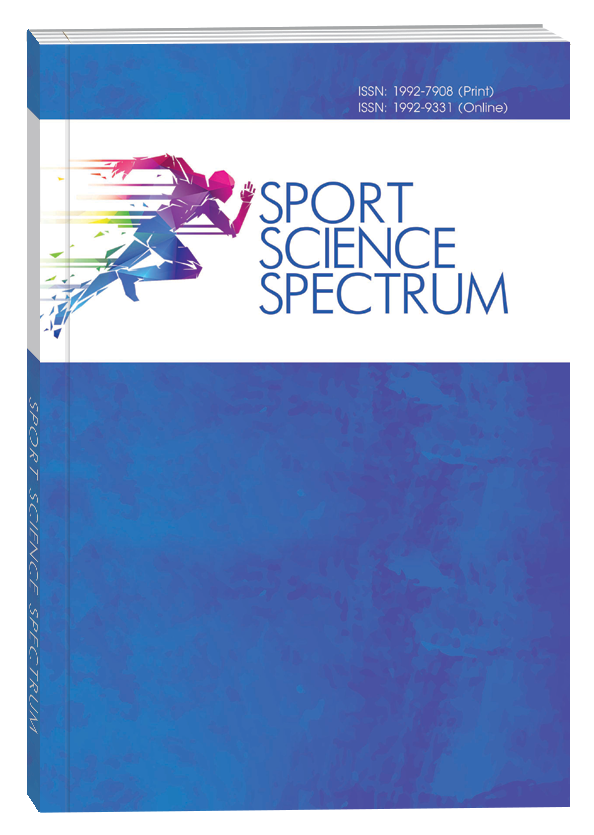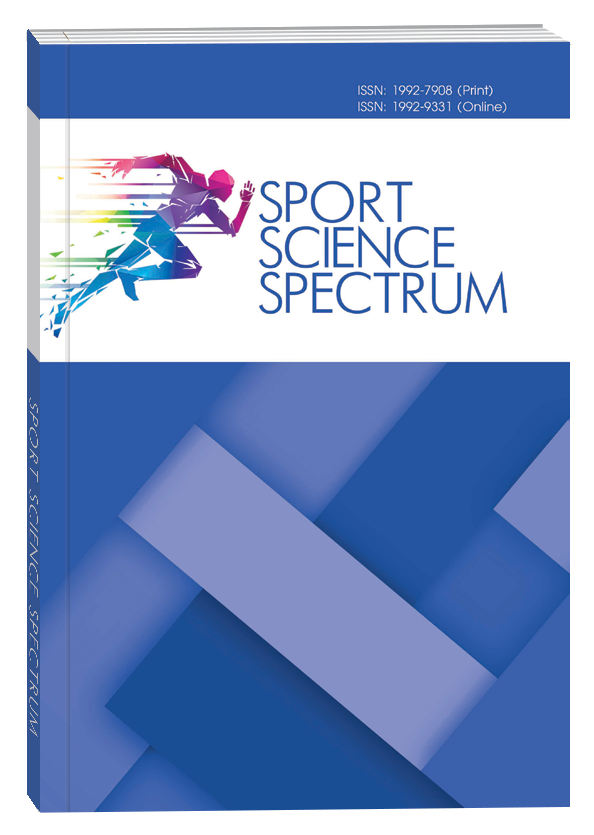MONITORING OF PHYSICAL DEVELOPMENT AND BODY COMPOSITION OF MATURE OFFICERS OF THE ARMED FORCES OF UKRAINE
DOI:
https://doi.org/10.32782/spectrum/2025-2-11Keywords:
officers, overweight, abdominal obesity, visceral fatAbstract
The article presents the results of a pedagogical experiment of officers who have undergone a comprehensive examination of the main indicators of physical development and body composition. The study involved 279 officers of mature age.The purpose of the study was to determine the prevalence of overweight and abdominal obesity among military officers of the Armed Forces of Ukraine.To achieve this goal, the following research methods were used: theoretical analysis of scientific literature on the topic with consistent analysis, synthesis and generalization of results; anthropometric methods; method of bioimpedance analysis of body composition; methods of mathematical statistics. The results of the study showed that the median waist circumference was 95.0 cm and had a moderate variation (V=12,8%). This indicates the presence of individuals at increased risk of metabolic diseases. In particular, 57,7% of officers have a waist circumference of more than 94,0 cm, which is a predictor of abdominal obesity and the risk of developing cardiovascular disease. The results of measuring the WHR index showed that 12,5% of officers have their own results exceeding 0,95 c.u. and indicating the presence of abdominal obesity. This leads to an increased risk of cardiovascular disease and metabolic syndrome. The results of the local distribution of body fat revealed the greatest accumulation of fat mass in the abdomen, with a median of 19,0 mm, 75-th percentile of 26,0 mm, and a maximum value of 48,0 mm. The analysis of body mass index showed that the median result was 27,7 kg·m2, and the 75-th percentile was 30,1 kg·m2, with a coefficient of variation of more than 14,6%. These data indicate the heterogeneity of the sample and the presence of overweight and obese individuals.Conclusion. Our findings emphasize the need to implement specialized programs for body weight correction. They should take into account the individual characteristics and needs of military personnel.
References
1. Петрачков О., Ярмак О. Аналіз фізичного розвитку і композиційного складу тіла офіцерів оперативного рівня Збройних сил України в умовах правового режиму воєнного стану. Вісник Прикарпатського університету. Фізична культура. 2023. Вип. 40. С. 67–76. DOI: 10.15330/fcult.40.67-76.
2. Петрачков О., Ярмак О. Аналіз показників фізичного розвитку офіцерів оперативного рівня різних вікових груп. Вісник Кам’янець-Подільського національного університету імені Івана Огієнка. Фізичне виховання, спорт і здоров’я людини. 2023. № 28(2). С. 122–129. DOI:10.32626/2309-8082.2023- 28(2).122–129.
3. Ярмак О., Черналівська О. Шевченко І. Аналіз фізичного розвитку і композиційного складу тіла жінок-військовослужбовців. Sport Science Spectrum. 2024. № 1. С. 122–128. DOI: 10.32782/spectrum/2024-1-19.
4. Andrieieva O., Nahorna A., Yarmak O. et al. Identification of informative physical condition indicators for self-training exercise programs design for mid- dle-aged overweight and obese women. Sport Mont. 2021. Vol. 19, № 2. P. 75–81. DOI: 10.26773/smj.210913.
5. Andrieieva O., Yarmak O., Palchuk M. et al. Monitoring the morphological and functional state of students during the transition from middle to high school during the physical education process. Journal of Physical Education and Sport. 2020. Vol. 20. P. 2110–2117. DOI: 10.7752/jpes.2020.s3284.
6. Benton D., Young H. A. Do small differences in hydration status affect mood and mental performance? Nutrition Reviews. 2015. Vol. 73, № 2. P. 83–96. DOI: 10.1093/nutrit/nuv045.
7. Blüher M. Obesity: global epidemiology and pathogenesis // Nature Reviews. Endocrinology. 2019. Vol. 15, № 5. P. 288–298. DOI: 10.1038/s41574-019-0176-8.
8. Carretero-Krug A., Úbeda N., Velasco C. et al. Hydration status, body composition, and anxiety status in aeronautical military personnel from Spain: a
cross-sectional study. Military Medical Research. 2021. Vol. 8, № 1. Article number: 35. DOI: 10.1186/s40779-021-00327-2.
9. Cialdella-Kam L., Bloedon T. K., Stone M. S. Body composition as a marker of performance and health in military personnel. Frontiers in Sports and Active Living. 2023. Vol. 5. Article number: 1223254. DOI: 10.3389/fspor.2023.1223254.
10. Dos Santos Bunn P., de Oliveira Meireles F., de Souza Sodré R. et al. Risk factors for musculoskeletal injuries in military personnel: a systematic review with meta-analysis. International Archives of Occupational and Environmental Health. 2021. Vol. 94, № 6. P. 1173–1189. DOI: 10.1007/s00420-021-01700-3.
11. Drozdovska S., Andrieieva O., Yarmak O., Blagii O. Personalization of health-promoting fitness programs for young women based on genetic factors. Journal of Physical Education and Sport. 2020. Vol. 20, № 1. P. 331–337. DOI: 10.7752/jpes.2020.s1046.
12. Millar S. R., Perry I. J., Phillips C. M. Anthropometric measures, predicted visceral adipose tissue and biomarkers of chronic inflammation. European Journal of Clinical Investigation. 2023. Article ID: e14104. DOI: 10.1111/eci.14104.
13. Orantes-Gonzalez E., Heredia-Jimenez J., Escabias M. Body mass index and aerobic capacity: The key variables for good performance in soldiers. European Journal of Sport Science. 2022. Vol. 22, № 10. P. 1467–1474. DOI: 10.1080/17461391.2021.1956599.
14. Peterson D. D. History of the U.S. Navy Body Composition Program. Military Medicine. 2015. Vol. 180, № 1. P. 91–96. DOI: 10.7205/MILMED-D-14-00266.
15. Petrachkov O., Yarmak O., Biloshitskiy V., Andrieieva O. et al. The influence of morphofunctional condition on the physical fitness level of Ukrainian soldiers. Journal of Physical Education and Sport. 2022. Vol. 22, № 9. P. 2182–2189. DOI: 10.7752/jpes.2022.09278.
16. Pross N. Effects of dehydration on brain functioning: a life-span perspective. Annals of Nutrition & Metabolism. 2017. Vol. 70, № 1. P. 30–36. DOI: 10.1159/000463060.
17. Reyes-Guzman C. M., Bray R. M., Forman-Hoffman V. L., Williams J. Overweight and obesity trends among active duty military personnel: a 13-year perspective. American Journal of Preventive Medicine. 2015. Vol. 48, № 2. P. 145–153. DOI: 10.1016/j.amepre.2014.08.033.
18. Rosa S. E., Costa A. C., Fortes M. S. R., et al. Development and validation of equations to estimate visceral adipose tissue in military men. Revista Brasileira de Medicina do Esporte. 2021. Vol. 27. P. 49–54. DOI:10.1590/1517-8692202127012020_0066.
19. Rosa S. E., Costa A. C., Fortes M. S., et al. Cut-off points of visceral adipose tissue associated with metabolic syndrome in military men. Healthcare (Basel, Switzerland). 2021. Vol. 9, № 7. Article number: 886. DOI: 10.3390/healthcare9070886.
20. Salimi Y., Taghdir M., Sepandi M., Karimi Zarchi A. A. The prevalence of overweight and obesity among Iranian military personnel: a systematic review and meta-analysis. BMC Public Health. 2019. Vol. 19. Article number: 162. DOI: 10.1186/s12889-019-6484-z.
21. Kashuba V., Andrieieva O., Yarmak O. et al. Morpho-functional screening of primary school students during the course of physical education. Journal of Human Sport and Exercise. 2021. Vol. 21, № 2. P. 748–756. DOI: 10.7752/jpes.2021.02093.
22. Wang S. H., Chung P. S., Lin Y. P., et al. Metabolically healthy obesity and physical fitness in military males in the CHIEF study. Scientific Reports. 2021. Vol. 11. Article number: 9088. DOI: 10.1038/s41598-021-88728-0.
23. Yarmak O. M., Trofimenko V. O., Marchenko O. Yu., Martyn P. M. Features of the morphofunctional state of adolescents with body mass deficiency. Rehabilitation & Recreation. 2023. Vol. 15. P. 193–201. DOI: 10.32782/2522-1795.2023.15.25.
24. Zhou J.-y., Ge H., Zhu M.-f., et al. Neck circumference as an independent predictive contributor to cardio-metabolic syndrome. Cardiovascular Diabe- tology. 2013. Vol. 12. P. 76. DOI: 10.1186/1475-2840-12-76.





